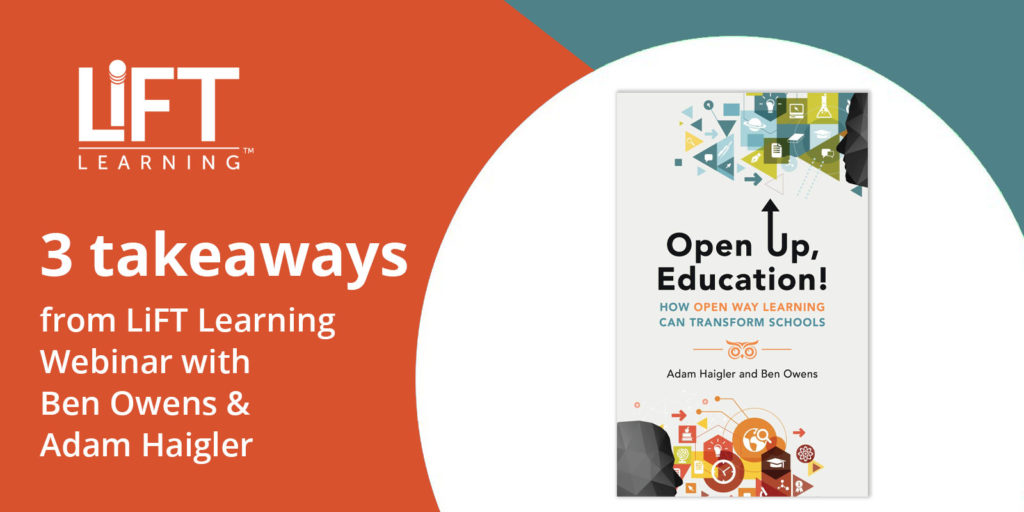Open Up, Education! 3 Takeaways on How Open Way Learning Can Transform Schools

From LiFT Learning’s Webinar Series
Authors Adam Haigler and Ben Owens met when teaching at Tri-County Early College, an innovative NC High School focused on the development of skills through learner-led projects. It was there that Adam and Ben put theory to practice working with youth to create, collaborate, and innovate. Over dinner with friends, the conversation turned to redesigning their school as part of XQ Super School Challenge as they discussed lessons and skills from outside of school that would be useful if applied inside the classroom walls. Common consensus revealed the most compelling, inspiring, and fulfilling attribute of work and life that was relatively absent in school – an open learning environment.
The seed was planted.
A two-year process produced Open Up, Education!: How Open Way Learning Can Transform Schools. We were fortunate to connect with co-authors and co-founders of the appropriately named Open Way Learning (OWL), a non-profit created to “help develop, sustain, and scale systems of learner-centered innovation that better prepare students for the realities of the 4th industrial revolution…”
Here are 3 takeaways from the conversation.
Collaboration is key
The dinner table conversation and thus the book translated the concept of open-source software, code made by an individual that anyone can see, modify and distribute as they see fit, into open learning. A learning environment where ideas and activities are made available for others to build off of, tinker with, and evolve in the spirit of the greater good. This gives a powerful name, open-source, to all that was occurring in the learner-led environment Adam and Ben were advocating for at Tri-County, “transparency, inclusivity, adaptability, collaboration, community, it speaks exactly to what we were building.”
It’s no surprise that an open learning environment calls upon a collaborative mindset. Prior to the classroom, Ben spent over twenty years as an engineer. He recalled his first impression when transitioning into education, “ the lack of collaboration between colleagues and constant level of desire to share ideas, observe each other, and learn from each other was disturbingly absent.” He went on to describe the workplace mindset, “If you were not constantly collaborating and thinking and innovating, you were irrelevant and out of business.”
Owens and Haigler advise educational leaders to start with a coalition of the willing and identify those who are bought in and excited about it. Once bought in, the ethos will extend beyond the teachers becoming the norm, “students will be recruiting a community member, a mentor, that is outside this school that will be informing this work.”
Systems change takes time
Creating a collaborative environment allowing for an open exchange of ideas is not work that is completed overnight. How to build a culture of collaboration often means how to change the status quo, many may want to collaborate but are not given an opportunity. Many times ‘forced collaboration,’ while well-intended, may have detrimental unintended results where individuals resist or return to isolationist practices.
Adam points to the Teacher-Powered Schools network as an example of a governance model where teachers are either the sole decision-makers or have a high degree of autonomy to make decisions in the school, “Once you distribute leadership down to the teacher level, typically what happens is it gets distributed even further to the student level because of the nature of those sorts of learning environments.”
No matter what system exists, as you shift the status quo to create a more collaborative learner-led environment, it will be critical for educators to let go.
Ben identified a common fear, “the teacher is not necessary in control saying you are going to do these 8 clear steps in this workgroup. No, you are going to get into an environment where you just start sharing ideas and trying things out and that is a leap of faith.” He went on to describe the powerful outcomes, “…when you scaffold it (learning) over time and when teachers collaborate with one another on how to get better at doing it, it really creates those conditions where collaboration can really be part of the entire ecosystem to students, to colleagues, to even parents and community members.”
Modern-day systems rely upon technology which must be considered when shifting to an open learning environment. Authors Ben and Adam called out the ever-present need for deep personalization in our schools and warn, “as is the acceleration of cheap personalization at the same time with “Algorithmic” learning being cast as personalized where certain software that makes a lot of promises to educators and districts (with very expensive licenses) just give them online worksheets that are adaptive to their level.”
That being said, there are platforms “…like LiFT that are out there that allow for deep and meaningful ways for students to work on completely different aspects of a curriculum all at the same time in a way that is manageable as an educator so you are not tracking down 40 different platforms.”
The underlying culture
To create an open learning environment rooted in systemic collaborative ethos, educational leaders must first tend to an institute’s foundational culture. As Ben describes, “there are often systemic cultural issues that must be addressed prior to any innovation to ensure the change will overcome any leadership changes or other headwinds.” And headwinds will come. These four questions can serve as a litmus test for the underlying culture of a school or district.
Are you living your mission and vision? The foundational purpose and reason for existing as an institution should be seen and felt by any member or visitor of your learning community.
Is there a sense of distributed leadership? Adam referenced John Hattie’s research, “collective teacher efficacy is the number one way to increase academic outcomes in a school. We have to have those conversations, facilitate these conversations to see what we do believe, see what comes up!”
Is there a culture of collaboration? Professional Learning Communities or Critical Friends Groups are one way to provide structure for educators to collaborate, nurturing a shared leadership environment allows for the culture of collaboration to find its way to the student level.
Do you have an open-source sharing environment? Open source vulnerable sharing, a willingness to share and grow to get better, is both an indicator of the health of an underlying culture and the output of a healthy culture.
Open Up, Education!: How Open Way Learning Can Transform Schools is an insightful and applicable resource for any school leader looking to create a culture of collaboration. Through anecdotes and research, readers will walk away with direct next steps.
Check out LiFT’s resource collection for more from Adam and Ben including recordings from the webinar and a parent companion guide.

As a New Hampshire educator at the forefront of the competency-based movement, Joey taught Cultural Geography in grades 9-12 at Pinkerton Academy. He was awarded New Hampshire’s Teacher of the Year in 2014 before taking a leadership role as Director of Education at Education First. At EF, he was responsible for improving the learning experience of participants in travel programs through accreditation, strategic partnerships, and product development.

